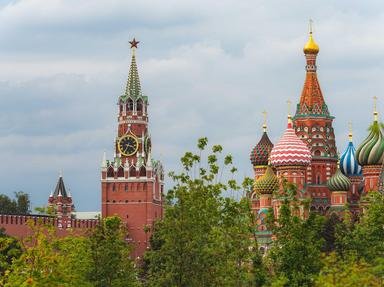Quiz Answer Key and Fun Facts
1. 1894, when Russia's last Tsar ascended to the Russian throne reluctantly and began his doomed rule. What was the name of this Russian Emperor?
2. When Tsar Nicholas II ascended to the throne, he had to contend with the issues of land hunger (the desire for good quality land) for the peasantry named the 'dark masses' by his wife, Tsarina Alexandra. What percentage of the Russian population consisted of these peasants when Nicholas II became Tsar, illustrating the difficulty of pacifying them?
3. In 1905, Russia saw two humiliating events demonstrating the weakness and repressive attitudes of the government. Can you tell me which war and which strike in a major Russian city evidences this?
4. The 1905 Revolution passed and the Tsar survived mainly due to the loyalty of his armed forces which put down rebellions in his name. Tsar Nicholas II and his close advisor Sergei Witte however did enact some concessions to appease some of the liberal opposition in Russia. What legal document was this?
5. We now focus on the period between 1906 and 1911 where the Tsarist government attempted to use the relative stability after the 1905 Revolution to secure its rule. One man, the Minister of Internal Affairs, had a profound impact on the political situation of Russia and attempted to modernise the peasantry. What was this man's name?
6. Before we arrive at the chaotic year of 1917, we need to first consider the origins of two radical parties who would alter the fate of Russia forever. They were once united as the Social Democratic Party of Russia but split in 1903. What were these two parties?
7. One final and abysmal decision Tsar Nicholas II made must be considered before the revolutions of 1917 are. In 1915, he made a stupid decision regarding the armed forces fighting against the Germans and Austro-Hungarians in the First World War which would turn his nation against him. What was it?
8. Now we arrive at February 1917, the first of the two revolutions to rock the Russian nation to its core. Tsar Nicholas II abdicated in March, 1917 at the behest of his closest advisors and now those who have seized power consolidate their rule. Two institutions now share power in Russia: who are they?
9. The 'Dual Authority' lasted for eight months, with the strains of war and the discontent of the people reaching a breaking point in October. There were many different groups who could have perhaps seized power but which one was it in the end that would seize power and maintain it for decades?
10. The most important event after the October 1917 Revolution we need to consider in our ten questions is the Russian Civil War and the attempt to remove the Bolsheviks from power. It is widely considered that the Bolsheviks had many advantages that allowed them to conquer their rivals. Which of these is NOT an advantage the Bolsheviks had during the Civil War.
Source: Author
Maxybillion
This quiz was reviewed by FunTrivia editor
bloomsby before going online.
Any errors found in FunTrivia content are routinely corrected through our feedback system.
